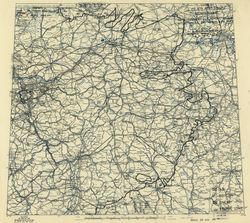 |
Lou Prucha WWII Service
|
 |
Magdenburg, Germany
(Built Up Area)

Pilot's Flight Log |

12th Army Group Situation Map 17-Apr-1945 |
piloting 669 Bomb Sq. A-26C-15-DT Invader, Serial # 43-22487, Fuselage code 2A-J.
Click to display the official 416th Bomb Group Mission Folder, Mission Report and Operational Report
scanned to PDF files by the Air Force Historical Research Agency (AFHRA).
Group, Unit and Historical Extracts for Mission 275
"416th Bombardment Group (L) - Group History 1945"
Transcribed from USAF Archives
The 17th was another two mission day. The heavily-defended city of Magdeburg was the target. Excellent results were scored on the town and its marshalling yard. One flight misidentified the target and caused extensive damage to buildings and roads 2 1/2 miles southwest of the original aiming point. The three box leaders were Major Dunn (Lts Brewer and Kerns, B&N), Lt Buskirk (Lt Hanna and F/O Przywitowski, B&N), and Lt Parker, Lt Shaft, B-N.
"Attack Bombers, We Need You! A History of the 416th Bomb Group"
Ralph Conte
Page 254
Mission #275 - 17 April - AM - Magdeburg Town. The Ninth Army was advancing across the Elbe River and this target was in the path they had detailed. There were eleven other bomb groups bombing this heavily defended town. Our ground forces were withdrawn about 1500 yards from the town, which was destined to be totally destroyed according to the high command. This was done, with all those groups going after it. This town was the heaviest organized resistance our ground forces had run into, signifying its importance to both fighting forces. The 416th provided three boxes to do their part, resulting in superior and excellent patterns of bomb drops. Major Dunn with BNs Brewer and Kerns led Box I. Lt. Buskirk with Lt. Hanna and F/O Przywitowski led the second box with Lt. Parker and Lt. Shaft, BN on Box II. Flights were headed up by Lt. Hall with F/O Coss BN and Lt. Errotabere and Lt. Wilbur BN. No flak was met.
"669th Bombardment Squadron (L) History"
Transcription from USAF Archives
Superior bombing results were obtained by the formation that attacked the defended town of Magdeburg. This attack was made on the morning of April 17th. Lt. Turner, with Lts. McGivern and Morley, led the Second Flight of the First Box, while Capt. DuFault, with Flight Officer Cardinale, led the Third Flight of the same box.
"History of 670th Bombardment Squadron (L)"
Transcription from USAF Archives
The fast pace of two missions a day was continued on the 17th of April 1945. 12 of our aircraft flew on the morning mission; target Magdeburg, which was maximum effort. Lt. Hall/F/O Goss and Lt. Errotabere/Lt. Wilbur led our flights with results reported as excellent to superior. 12 crews also participated in the second mission for the day, #276, and the target, Tubingen Ordnance Depot. Results were good to excellent. Lt. Popeney/Lt. Fry and Lt. Heinke/Lt Rosenquist, Lt. Pavey led our flights. This was the first mission for Lt. Pavey and Lt. Peppers, Navigators.
No missions were flown on the 18th of April 1945.
"671st Bomb Squadron (L) Unit History"
Gordon Russell and Jim Kerns
The heavily defended city of Magdeburg, standing in the way of the Ninth Army’s advance across the Elbe River, was pounded for nearly four hours on the morning of April 17th as the ten other bomb division groups dropped tons of explosives on the defended town. Major Dunn, Lt. Brewer and Lt. Kerns led the formation and bombs from their flight fell into the town with superior results. Lt. Buskirk and Lt. Hanna led the second box, but received an undetermined as the target ran off the edge of the film. Visual observation indicated that the bombs fell in the town with excellent results. There was no battle damage.
The 416th was the first Group to bomb the defended city after ground forces withdrew 1,500 yards. The order was to completely level the town. U.S. forces have met their heaviest organized resistance since the breakthrough at that point.
"USAAF Chronology of WWII, month by month"
Ninth Air Force: In Germany, the 9th Bombardment Division attacks the defended city of Magdeburg (including numerous gun positions in the area), marshalling yard and ordnance depot at Aalen, marshalling yard and ordnance depot at Tubingen, and ordnance depot at Ravensburg; fighters fly escort to the bombers, fly patrols, area cover, and armed reconnaissance, hit airfields at Marianske Lazne and Michalovy Hory, and support the US 3d Armored Division mopping up S of the Elbe River and W of the Mulde River near Dessau, the 9th Armored Division along the Mulde E of Leipzig, the VIII Corps in the Greiz-Zwickau area, the XX Corps SW of Chemnitz, the 5th Armored Division at the Knesebeck Forest, S of Wittingen, and the 2d Armored Division opening an assault on Magdeburg. Unit moves in Germany: HQ 48th Fighter Group and 493d and 494th Fighter Squadrons from Kelz to Kassel with P-47s; the 15th Tactical Reconnaissance Squadron, 10th Tactical Reconnaissance Group, from Ober Olm to Erfurt with F-6s; the 158th Liaison Squadron, Ninth AF (attached to Twelfth Army Group), from Celles, Belgium to Ahrweiler with L-5s.